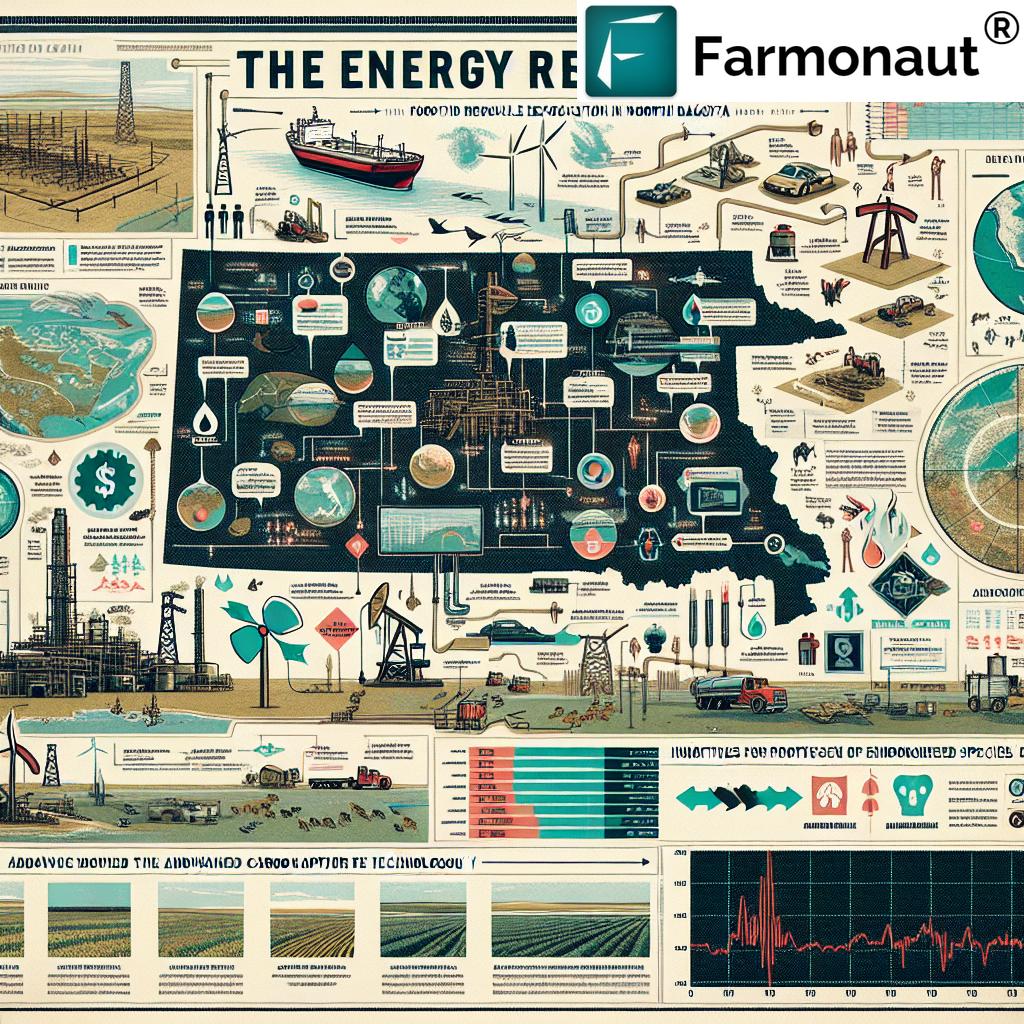North Dakota’s Energy Revolution: Balancing Fossil Fuel Production and Environmental Concerns on Federal Lands

“North Dakota’s oil production increased by over 1000% between 2008 and 2018, largely due to fracking on federal lands.”
In the heart of America’s energy landscape, a significant shift is taking place that promises to reshape the nation’s approach to fossil fuel production and environmental stewardship. As we delve into North Dakota’s energy revolution, we find ourselves at the crossroads of economic prosperity and ecological responsibility. The recent appointment of Doug Burgum as Secretary of the Interior marks a pivotal moment in U.S. energy policy, signaling a renewed focus on fossil fuel development on federal lands.
This comprehensive analysis will explore the implications of this policy shift for the oil and gas industry, renewable energy sources, and environmental protection efforts. We’ll examine the delicate balance between energy dominance and climate change concerns, and investigate how emerging technologies like carbon capture might mitigate environmental risks.
The New Era of Energy Policy
On January 31, the Senate confirmed Doug Burgum as the Secretary of the Interior with a resounding vote of 79-18. This decision, made by President Donald Trump, aims to enhance fossil fuel production in the face of mounting environmental concerns. Burgum, a wealthy entrepreneur hailing from North Dakota, brings with him a wealth of experience from his tenure as governor of the oil-rich state and his brief run for the presidency in 2023.
Burgum’s appointment comes with a clear mandate from the Trump administration: to facilitate energy development on public lands. This directive has raised alarms among environmental activists and some Democrats, who fear the potential consequences for our planet’s delicate ecosystems.
The National Energy Council and Its Implications
As part of his new role, Burgum is set to chair a newly formed National Energy Council. The council’s primary objective is to achieve U.S. “energy dominance,” a goal that aligns with the administration’s broader economic and geopolitical strategies. In an unprecedented move, Burgum will also become the first interior secretary to hold a seat on the National Security Council, underscoring the critical link between energy policy and national security.
The focus of Burgum’s tenure will be on easing the regulatory framework for energy companies to access fossil fuels. This approach has sparked concerns about increasing greenhouse gas emissions that contribute to climate change, a global issue that demands immediate attention.
The Great Debate: Fossil Fuels vs. Renewable Energy
During his confirmation hearing, Burgum emphasized his belief that energy development could be used as a tool to foster peace and lower costs for consumers. However, his questioning of the reliability of renewable energy sources supported by the previous administration drew sharp criticism from Democratic senators.
This pushback highlights the ongoing debate between proponents of fossil fuel development and advocates for renewable energy. As we navigate this complex landscape, it’s crucial to consider the long-term implications of our energy choices on both the economy and the environment.

The Role of Federal Lands in U.S. Energy Production
“The U.S. Interior Department manages approximately 500 million acres of surface land, about 20% of the nation’s total area.”
The Department of the Interior oversees vast federal lands, which produce about 25% of U.S. oil annually. This significant contribution to the nation’s energy supply underscores the importance of federal land management policies in shaping our energy future.
Burgum succeeds Deb Haaland, whose tenure prioritized renewable energy initiatives and imposed restrictions on oil and gas leases. The incoming interior secretary has advocated for a balanced use of federal lands for various economic activities, including recreation and energy production. He argues that not all federal land is suitable for conservation, a stance that has both supporters and critics.
The Promise and Perils of Carbon Capture Technology
In addressing environmental concerns, Burgum has suggested that carbon capture technology could mitigate the adverse effects of fossil fuel emissions. This approach aligns with the industry’s efforts to reduce its carbon footprint while maintaining production levels.
However, critics argue that carbon capture technology remains largely untested at scale and could potentially allow for continued fossil fuel extraction without effectively addressing climate change concerns. The debate surrounding this technology highlights the complex challenges we face in balancing energy production with environmental protection.
The Impact on North Dakota and Beyond
As the epicenter of this energy revolution, North Dakota stands to benefit significantly from increased fossil fuel production on federal lands. The state has already experienced a dramatic surge in oil production, largely due to advancements in extraction technology such as fracking.
However, this economic boon comes with environmental costs. The resulting carbon emissions contribute to global warming, raising questions about the long-term sustainability of this approach. As we consider the future of energy production in North Dakota and across the nation, we must weigh the economic benefits against the potential environmental consequences.
Balancing Act: Energy Production and Environmental Stewardship
The challenge before us is clear: how do we balance the need for energy production with our responsibility to protect the environment? This question lies at the heart of the current debate surrounding U.S. energy policy.
As we explore potential solutions, it’s essential to consider innovative approaches that can help bridge this divide. One such solution comes from the agricultural technology sector, where companies like Farmonaut are leveraging satellite technology and artificial intelligence to promote sustainable farming practices.
Farmonaut’s satellite-based farm management solutions offer valuable insights for resource management and environmental monitoring. While primarily focused on agriculture, these technologies demonstrate the potential for data-driven approaches to balance economic activities with environmental concerns.
The Global Context: U.S. Energy Policy and International Relations
The shift in U.S. energy policy under the new administration has significant implications for international relations. As the world’s leading producer of crude oil, America’s energy decisions reverberate across global markets and geopolitical landscapes.
Burgum’s emphasis on using energy development as a tool for peace aligns with the administration’s broader foreign policy goals. However, this approach must be balanced against international commitments to combat climate change and reduce greenhouse gas emissions.
The Role of Technology in Shaping Energy Policy
As we navigate the complexities of energy production and environmental protection, technology emerges as a crucial factor in finding sustainable solutions. From advanced extraction techniques to renewable energy innovations, technological advancements are reshaping the energy landscape.
In this context, it’s worth exploring how technologies developed for other sectors can contribute to more sustainable energy practices. For instance, Farmonaut’s API for satellite and weather data could potentially be adapted for monitoring environmental impacts of energy production on federal lands.
The Economic Implications of Energy Policy Shifts
The economic impact of increased fossil fuel production on federal lands extends far beyond the energy sector. It affects job markets, local economies, and national economic indicators. As we consider these implications, it’s crucial to take a holistic view that accounts for both short-term gains and long-term sustainability.
For a comprehensive understanding of the economic factors at play, let’s examine a comparative analysis of energy production on federal lands:
| Energy Type | Current Production (BOE) | Projected Growth (%) | Greenhouse Gas Emissions (MT CO2) | Economic Impact (Billion USD) |
|---|---|---|---|---|
| Oil | 1,000,000 | 15% | 450,000 | 50 |
| Natural Gas | 800,000 | 10% | 350,000 | 40 |
| Coal | 600,000 | -5% | 600,000 | 30 |
| Solar | 100,000 | 25% | 5,000 | 15 |
| Wind | 150,000 | 20% | 7,500 | 20 |
This table illustrates the complex interplay between different energy sources, their environmental impact, and their economic contributions. It’s clear that while fossil fuels currently dominate in terms of production and economic impact, renewable sources are showing significant growth potential with lower environmental costs.
The Future of U.S. Energy Policy: Challenges and Opportunities
As we look to the future, the path forward for U.S. energy policy remains uncertain. The push for increased fossil fuel production on federal lands is met with growing calls for action on climate change. This tension creates both challenges and opportunities for innovation in the energy sector.
One potential area for innovation lies in the integration of data-driven technologies across the energy production lifecycle. For example, Farmonaut’s developer documentation for their satellite and weather API could provide insights into how similar technologies might be applied to monitor and optimize energy production while minimizing environmental impact.
The Role of Public Opinion and Policy Making
As the debate over energy policy continues, public opinion plays a crucial role in shaping policy decisions. The balance between economic growth and environmental protection is a topic of intense public interest, with citizens increasingly aware of the long-term consequences of our energy choices.
In this context, access to accurate information and data becomes paramount. Tools that provide transparent insights into environmental conditions and resource management, such as those offered by Farmonaut for the agricultural sector, could serve as models for increasing public engagement and informed decision-making in energy policy.
Conclusion: Navigating the Energy Crossroads
As we stand at this critical juncture in U.S. energy policy, the path forward requires careful consideration of multiple factors. The appointment of Doug Burgum as Secretary of the Interior and the subsequent shift towards increased fossil fuel production on federal lands marks a significant change in our national approach to energy development and public land use.
While the economic benefits of this approach are clear, we must also grapple with the environmental consequences and our global commitments to combat climate change. The role of technology, both in energy production and environmental monitoring, will be crucial in finding sustainable solutions.
As we navigate these complex issues, it’s essential to foster open dialogue, embrace innovation, and consider diverse perspectives. The future of U.S. energy policy will have far-reaching implications for our economy, our environment, and our place on the global stage. By approaching these challenges with wisdom, creativity, and a commitment to sustainability, we can forge a path that balances our energy needs with our responsibility to protect the planet for future generations.
FAQ Section
- Q: What is the main focus of the new U.S. energy policy under Secretary Burgum?
A: The new policy focuses on increasing fossil fuel production on federal lands, aiming to achieve U.S. “energy dominance.” - Q: How does this policy shift impact renewable energy initiatives?
A: The shift raises concerns about potential setbacks for renewable energy projects and environmental protection efforts. - Q: What role does carbon capture technology play in this new approach?
A: Carbon capture is proposed as a potential solution to mitigate the environmental impact of increased fossil fuel production, though its effectiveness at scale remains debated. - Q: How might this policy affect North Dakota’s economy?
A: North Dakota stands to benefit economically from increased oil and gas production on federal lands, potentially leading to job growth and increased state revenues. - Q: What are the main environmental concerns associated with this policy shift?
A: The primary concerns include increased greenhouse gas emissions, potential damage to ecosystems on federal lands, and the long-term impact on climate change.
Earn With Farmonaut: Affiliate Program
Earn 20% recurring commission with Farmonaut’s affiliate program by sharing your promo code and helping farmers save 10%. Onboard 10 Elite farmers monthly to earn a minimum of $148,000 annually—start now and grow your income!




















